Subclass: Theria
Infraclass: Metatheria
Superorder: Ameridelphia
Order: Didelphimorphia (common opossums)

Didelphimorphia is the order of common opossums of the Western Hemisphere. Opossums probably diverged from the basic South American marsupials in the late Cretaceous or early Paleocene. They are small to medium-sized marsupials, about the size of a large house cat, with a long snout and prehensile tail.
- Family: Didelphidae (American opossums)
- Subfamily: Didelphinae
- Genus: Thylamys
- Elegant fat-tailed mouse opossum, Thylamys elegans LC
- White-bellied fat-tailed mouse opossum, Thylamys pallidior LC
- Genus: Thylamys
- Subfamily: Didelphinae
Order: Paucituberculata (shrew opossums)
There are six extant species of shrew opossum. They are small shrew-like marsupials confined to the Andes.
- Family: Caenolestidae
- Genus: Rhyncholestes
- Long-nosed caenolestid, R. raphanurusNT
- Genus: Rhyncholestes
Superorder: Australidelphia
Order: Microbiotheria (monito del monte)

The monito del monte is the only extant member of its family and the only surviving member of an ancient order, Microbiotheria. It appears to be more closely related to Australian marsupials than to other Neotropic marsupials; this is a reflection of the South American origin of all Australasian marsupials. [1]
- Family: Microbiotheriidae
- Genus: Dromiciops
- Monito del monte, D. gliroidesNT
- Genus: Dromiciops
Infraclass: Eutheria
Superorder: Xenarthra
Order: Cingulata (armadillos)

Armadillos are small mammals with a bony armored shell. There are 21 extant species in the Americas, 19 of which are only found in South America, where they originated. Their much larger relatives, the pampatheres and glyptodonts, once lived in North and South America but became extinct following the appearance of humans.
- Family: Chlamyphoridae (armadillos)
- Subfamily: Euphractinae
- Genus: Chaetophractus
- Andean hairy armadillo, Chaetophractus nationiVU
- Big hairy armadillo, Chaetophractus villosus LC
- Genus: Zaedyus
- Pichi, Zaedyus pichiyNT
- Genus: Chaetophractus
- Subfamily: Euphractinae
Superorder: Euarchontoglires
Order: Rodentia (rodents)






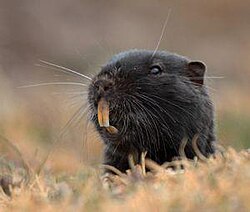
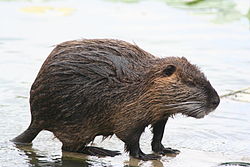
Rodents make up the largest order of mammals, with over 40% of mammalian species. They have two incisors in the upper and lower jaw which grow continually and must be kept short by gnawing. Most rodents are small though the capybara can weigh up to 45 kg (99 lb).
- Suborder: Hystricognathi
- Family: Chinchillidae (viscachas and chinchillas)
- Genus: Chinchilla
- Short-tailed chinchilla, Chinchilla brevicaudataCR
- Long-tailed chinchilla, Chinchilla lanigeraCR
- Genus: Lagidium
- Southern viscacha, Lagidium viscacia LC
- Northern viscacha, Lagidium peruanum LC
- Wolffsohn's viscacha, Lagidium wolffsohniDD
- Genus: Chinchilla
- Family: Caviidae (guinea pigs)
- Subfamily: Caviinae
- Genus: Cavia
- Montane guinea pig, Cavia tschudii LC
- Genus: Galea
- Common yellow-toothed cavy, Galea musteloides LC
- Genus: Microcavia
- Southern mountain cavy, Microcavia australis LC
- Andean mountain cavy, Microcavia niata LC
- Genus: Cavia
- Subfamily: Caviinae
- Family: Ctenomyidae
- Genus: Ctenomys
- Coyhaique tuco-tuco, Ctenomys coyhaiquensisDD
- Tawny tuco-tuco, Ctenomys fulvus LC
- Magellanic tuco-tuco, Ctenomys magellanicusVU
- Maule tuco-tuco, Ctenomys maulinus LC
- Highland tuco-tuco, Ctenomys opimus LC
- Genus: Ctenomys
- Family: Octodontidae
- Genus: Aconaemys
- Chilean rock rat, Aconaemys fuscus LC
- Porter's rock rat, Aconaemys porteriDD
- Sage's rock rat, Aconaemys sageiDD
- Genus: Octodon
- Bridges's degu, Octodon bridgesiVU
- Common degu, Octodon degus LC
- Moon-toothed degu, Octodon lunatusNT
- Pacific degu, Octodon pacificusCR
- Genus: Octodontomys
- Mountain degu, Octodontomys gliroides LC
- Genus: Spalacopus
- Coruro, Spalacopus cyanus LC
- Genus: Aconaemys
- Family: Abrocomidae
- Genus: Abrocoma
- Bennett's chinchilla rat, Abrocoma bennettii LC
- Ashy chinchilla rat, Abrocoma cinerea LC
- Genus: Abrocoma
- Family: Myocastoridae (coypus)
- Family: Chinchillidae (viscachas and chinchillas)
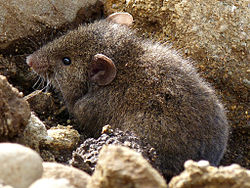

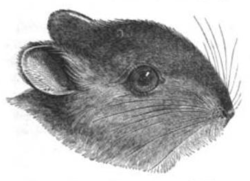

- Suborder: Sciurognathi
- Family: Cricetidae
- Subfamily: Sigmodontinae
- Genus: Abrothrix
- Andean Altiplano mouse, Abrothrix andinus LC
- Hershkovitz's grass mouse, Abrothrix hershkovitzi LC
- Woolly grass mouse, Abrothrix lanosus LC
- Long-haired grass mouse, Abrothrix longipilis LC
- Olive grass mouse, Abrothrix olivaceus LC
- Sanborn's grass mouse, Abrothrix sanborniNT
- Genus: Akodon
- White-bellied grass mouse, Akodon albiventer LC
- Bolivian grass mouse, Akodon boliviensis LC
- Intelligent grass mouse, Akodon iniscatus LC
- Genus: Andinomys
- Andean mouse, Andinomys edax LC
- Genus: Auliscomys
- Bolivian big-eared mouse, Auliscomys boliviensis LC
- Painted big-eared mouse, Auliscomys pictus LC
- Andean big-eared mouse, Auliscomys sublimis LC
- Genus: Calomys
- Andean vesper mouse, Calomys lepidus LC
- Genus: Chelemys
- Magellanic long-clawed akodont, Chelemys delfiniDD
- Andean long-clawed mouse, Chelemys macronyx LC
- Large long-clawed mouse, Chelemys megalonyxNT
- Genus: Chinchillula
- Altiplano chinchilla mouse, Chinchillula sahamae LC
- Genus: Eligmodontia
- Morgan's gerbil mouse, Eligmodontia morgani LC
- Andean gerbil mouse, Eligmodontia puerulus LC
- Genus: Euneomys
- Patagonian chinchilla mouse, Euneomys chinchilloidesDD
- Biting chinchilla mouse, Euneomys mordax LC
- Peterson's chinchilla mouse, Euneomys petersoni LC
- Genus: Galenomys
- Garlepp's mouse, Galenomys garleppiDD
- Genus: Geoxus
- Long-clawed mole mouse, Geoxus valdivianus LC
- Genus: Irenomys
- Chilean climbing mouse, Irenomys tarsalis LC
- Genus: Loxodontomys
- Southern big-eared mouse, Loxodontomys micropus LC
- Pikumche pericote, Loxodontomys pikumche LC
- Genus: Neotomys
- Andean swamp rat, Neotomys ebriosus LC
- Genus: Oligoryzomys
- Long-tailed pygmy rice rat, Oligoryzomys longicaudatus LC
- Magellanic pygmy rice rat, Oligoryzomys magellanicus LC
- Genus: Pearsonomys
- Pearson's long-clawed akodont, Pearsonomys annectensVU
- Genus: Phyllotis
- Darwin's leaf-eared mouse, Phyllotis darwini LC
- Lima leaf-eared mouse, Phyllotis limatus LC
- Master leaf-eared mouse, Phyllotis magister LC
- Osgood's leaf-eared mouse, Phyllotis osgoodiDD
- Yellow-rumped leaf-eared mouse, Phyllotis xanthopygus LC
- Genus: Reithrodon
- Bunny rat, Reithrodon auritus LC
- Genus: Abrothrix
- Subfamily: Sigmodontinae
- Family: Muridae (mice, rats, voles, gerbils, hamsters, etc.)
- Subfamily: Murinae
- Genus: Rattus
- Polynesian rat, Rattus exulans LC
- Genus: Rattus
- Subfamily: Murinae
- Family: Cricetidae
Superorder: Laurasiatheria
Order: Chiroptera (bats)



The bats' most distinguishing feature is that their forelimbs are developed as wings, making them the only mammals capable of flight. Bat species account for about 20% of all mammals.
- Family: Vespertilionidae
- Subfamily: Myotinae
- Genus: Myotis
- Atacama myotis, Myotis atacamensisNT
- Chilean myotis, Myotis chiloensis LC
- Genus: Myotis
- Subfamily: Vespertilioninae
- Genus: Histiotus
- Big-eared brown bat, Histiotus macrotus LC
- Southern big-eared brown bat, Histiotus magellanicus] LC
- Small big-eared brown bat, Histiotus montanus LC
- Genus: Lasiurus
- Desert red bat, Lasiurus blossevillii LC
- Hoary bat, Lasiurus cinereus LC
- Cinnamon red bat, Lasiurus varius LC
- Genus: Histiotus
- Subfamily: Myotinae
- Family: Molossidae
- Genus: Eumops
- Western mastiff bat, Eumops perotis LC
- Genus: Mormopterus
- Kalinowski's mastiff bat, Mormopterus kalinowskii LC
- Genus: Tadarida
- Mexican free-tailed bat, Tadarida brasiliensis LC
- Genus: Eumops
- Family: Phyllostomidae
- Subfamily: Stenodermatinae
- Genus: Sturnira
- Little yellow-shouldered bat, Sturnira lilium LC
- Genus: Sturnira
- Subfamily: Desmodontinae
- Genus: Desmodus
- Common vampire bat, Desmodus rotundus LC
- Genus: Desmodus
- Subfamily: Stenodermatinae
- Family: Furipteridae
- Genus: Amorphochilus
- Smoky bat, Amorphochilus schnabliiEN
- Genus: Amorphochilus
Order: Carnivora (carnivorans)
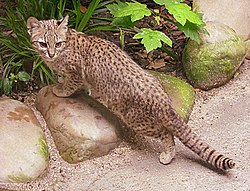
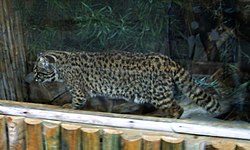
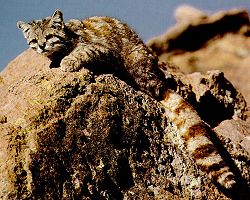

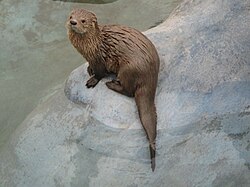

There are over 260 species of carnivorans, the majority of which feed primarily on meat. They have a characteristic skull shape and dentition.
- Suborder: Feliformia
- Family: Felidae (cats)
- Subfamily: Felinae
- Genus: Leopardus
- Pampas cat L. colocolaNT [2]
- Geoffroy's cat L. geoffroyiLC [3]
- Kodkod, L. guignaVU [4]
- Andean mountain cat L. jacobitusEN [5]
- Genus: Puma
- Genus: Leopardus
- Subfamily: Felinae
- Family: Felidae (cats)
- Suborder: Caniformia
- Family: Canidae (dogs, foxes)
- Genus: Dusicyon
- Genus: Lycalopex
- Culpeo, Lycalopex culpaeus LC
- Darwin's fox, Lycalopex fulvipesCR
- South American gray fox, Lycalopex griseus LC
- Family: Procyonidae (raccoons)
- Genus: Nasua
- South American coati, Nasua nasua LC introduced
- Genus: Nasua
- Family: Mustelidae, (mustelids)
- Genus: Galictis
- Lesser grison, Galictis cuja LC
- Genus: Lyncodon
- Patagonian weasel, Lyncodon patagonicus LC
- Genus: Lontra
- Marine otter, Lontra felinaEN
- Southern river otter, Lontra provocaxEN
- Genus: Neogale
- American mink, N. vison LC introduced
- Genus: Galictis
- Family: Mephitidae
- Genus: Conepatus
- Molina's hog-nosed skunk, Conepatus chinga LC
- Humboldt's hog-nosed skunk, Conepatus humboldtii LC
- Genus: Conepatus
- Clade: Pinnipedia (seals, sea lions and walruses)
- Family: Otariidae (eared seals, sea lions)
- Genus: Arctocephalus
- South American fur seal, Arctocephalus australis LC
- Antarctic fur seal, Arctocephalus gazella LC
- Juan Fernandez fur seal, Arctocephalus philippiiNT
- Subantarctic fur seal, Arctocephalus tropicalis LC
- Genus: Otaria
- South American sea lion, Otaria flavescens LC
- Genus: Arctocephalus
- Family: Phocidae, (earless seals)
- Genus: Hydrurga
- Leopard seal, Hydrurga leptonyx LC
- Genus: Mirounga
- Southern elephant seal, Mirounga leonina LC
- Genus: Hydrurga
- Family: Otariidae (eared seals, sea lions)
- Family: Canidae (dogs, foxes)
Order: Artiodactyla (even-toed ungulates and cetaceans)
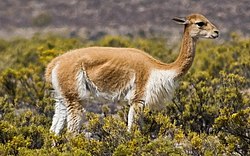

The weight of even-toed ungulates is borne about equally by the third and fourth toes, rather than mostly or entirely by the third as in perissodactyls. There are about 220 noncetacean artiodactyl species, including many that are of great economic importance to humans.
- Family: Camelidae (camels, llamas)
- Family: Cervidae (deer)
- Subfamily: Capreolinae
- Genus: Hippocamelus
- Taruca, Hippocamelus antisensisVU
- South Andean deer, Hippocamelus bisulcusEN
- Genus: Pudu
- Southern pudú, Pudu pudaVU
- Genus: Hippocamelus
- Subfamily: Cervinae
- Genus: Dama
- European fallow deer, D. dama LC introduced [7]
- Genus: Cervus
- Red deer, C. elaphus LC introduced
- Genus: Dama
- Subfamily: Capreolinae
- Family: Suidae
Infraorder: Cetacea (whales, dolphins and porpoises)



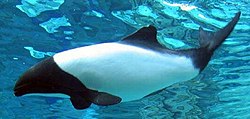





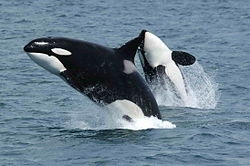

The infraorder Cetacea includes whales, dolphins and porpoises. They are the mammals most fully adapted to aquatic life with a spindle-shaped nearly hairless body, protected by a thick layer of blubber, and forelimbs and tail modified to provide propulsion underwater. Their closest extant relatives are the hippos, which are artiodactyls, from which cetaceans descended; cetaceans are thus also artiodactyls.
- Parvorder: Mysticeti
- Family: Balaenidae
- Genus: Eubalaena
- Southern right whale, Eubalaena australis LC
- Genus: Eubalaena
- Family: Balaenopteridae
- Subfamily: Balaenopterinae
- Genus: Balaenoptera
- Common minke whale, Balaenoptera acutorostrata LC
- Antarctic minke whale, Balaenoptera bonaerensisNT
- Sei whale, Balaenoptera borealisEN
- Bryde's whale, Balaenoptera edeniDD
- Blue whale, Balaenoptera musculusEN
- Fin whale, Balaenoptera physalusVU
- Genus: Balaenoptera
- Subfamily: Megapterinae
- Genus: Megaptera
- Humpback whale, Megaptera novaeangliae LC
- Genus: Megaptera
- Subfamily: Balaenopterinae
- Family: Neobalaenidae
- Genus: Caperea
- Pygmy right whale, Caperea marginata LC
- Genus: Caperea
- Family: Balaenidae
- Parvorder: Odontoceti
- Family: Physeteridae
- Genus: Physeter
- Sperm whale, Physeter macrocephalusVU
- Genus: Physeter
- Family: Kogiidae
- Genus: Kogia
- Pygmy sperm whale, Kogia brevicepsDD
- Dwarf sperm whale, Kogia simaDD
- Genus: Kogia
- Family: Ziphidae
- Genus: Ziphius
- Cuvier's beaked whale, Ziphius cavirostris LC
- Genus: Berardius
- Arnoux's beaked whale, Berardius arnuxiiDD
- Genus: Tasmacetus
- Shepherd's beaked whale, Tasmacetus shepherdiDD
- Subfamily: Hyperoodontinae
- Genus: Hyperoodon
- Southern bottlenose whale, Hyperoodon planifrons LC
- Genus: Mesoplodon
- Blainville's beaked whale, Mesoplodon densirostrisDD
- Ginkgo-toothed beaked whale, Mesoplodon ginkgodensDD
- Gray's beaked whale, Mesoplodon grayiDD
- Hector's beaked whale, Mesoplodon hectoriDD
- Strap-toothed whale, Mesoplodon layardiiDD
- Spade-toothed whale, Mesoplodon traversiiDD
- Genus: Hyperoodon
- Genus: Ziphius
- Superfamily: Delphinoidea
- Family: Phocoenidae (porpoises) LC
- Genus: Phocoena
- Spectacled porpoise, Phocoena dioptrica LC
- Burmeister's porpoise, Phocoena spinipinnisNT
- Genus: Phocoena
- Family: Delphinidae (marine dolphins)
- Genus: Cephalorhynchus
- Commerson's dolphin, Cephalorhynchus commersonii LC
- Chilean dolphin, Cephalorhynchus eutropiaNT
- Genus: Steno
- Rough-toothed dolphin, Steno bredanensis LC
- Genus: Tursiops
- Common bottlenose dolphin, Tursiops truncatus LC
- Genus: Stenella
- Spinner dolphin, Stenella longirostris LC
- Genus: Delphinus
- Long-beaked common dolphin, Delphinus capensisDD
- Short-beaked common dolphin, Delphinus delphis LC
- Genus: Lagenorhynchus
- Peale's dolphin, Lagenorhynchus australisDD
- Hourglass dolphin, Lagenorhynchus cruciger LC
- Dusky dolphin, Lagenorhynchus obscurusDD
- Genus: Lissodelphis
- Southern right whale dolphin, Lissodelphis peronii LC
- Genus: Grampus
- Risso's dolphin, Grampus griseus LC
- Genus: Orcinus
- Orca, Orcinus orcaDD
- Genus: Pseudorca
- False killer whale, Pseudorca crassidensNT
- Genus: Globicephala
- Long-finned pilot whale, Globicephala melas LC
- Genus: Cephalorhynchus
- Family: Phocoenidae (porpoises) LC
- Family: Physeteridae